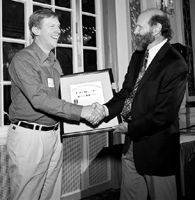Bridging the Gap Between Microstructure and Macroscopic Behavior of Composites
October 31, 2003

Graeme Milton (left) accepted the Ralph E. Kleinman Prize from SIAM president Mac Hyman at the 2003 SIAM Annual Meeting.
The Kleinman Prize, established in 1998 to recognize outstanding contributions that "bridge the gap between mathematics and applications," found an apt recipient in Milton. He has, according to the prize committee, produced "new examples of composites with exactly computable properties; new methods for bounding effective moduli; and new links between the analysis of composites, the calculus of variations, and partial differential equations."
A Salt Lake City Tribune reporter (Milton teaches at the University of Utah, where he was named a Distinguished Professor in 1999 and has chaired the mathematics department since 2002) captured the spirit of Milton's research in a 1999 article: His work "is based on the principle that the properties of a material are dictated by the material's internal structure. He finds or dreams up geometric structures, then uses complicated mathematical formulas to prove they have certain desired properties."
Physicists, materials scientists and applied mathematicians have a long-standing interest in composites, says Robert Kohn of the Courant Institute (who in 1999 was the first recipient of the Kleinman Prize). Current heightened interest in the subject, Kohn continues, owes much to newly understood links to optimal design and the calculus of variations, and to the discovery of new methods for bounding effective moduli; Milton's work, "more than that of any other single individual, has driven this activity."
Many bulk properties of materials are characterized by certain measurable parameters, or moduli, depending in general on the frequency of the applied fields. For example, creep, which describes how a material stretches or responds to a force that pulls it, and relaxation are both related to the dynamic function that describes the response to a sine wave input.
One important issue is how such moduli or dynamic responses can be accurately measured from available data. Milton (with Eyre and Lakes) has produced a method for finding tight bounds on effective moduli of viscoelastic materials from experimental measurements of relaxation data at a few discrete frequencies. In many cases, the method yields tight bounds on the moduli at unmeasured frequencies. By adopting this approach, experimentalists can concentrate their efforts on gathering more accurate data at a few frequencies, rather than across many frequencies, allowing the techniques to generate the data numerically at other frequencies.
"Graeme has one foot planted firmly in physics and the other just as firmly in mathematics," Kohn says. As the Kleinman Prize citation concludes, "His scientific vision . . . has revolutionized the subject" of composite materials.

